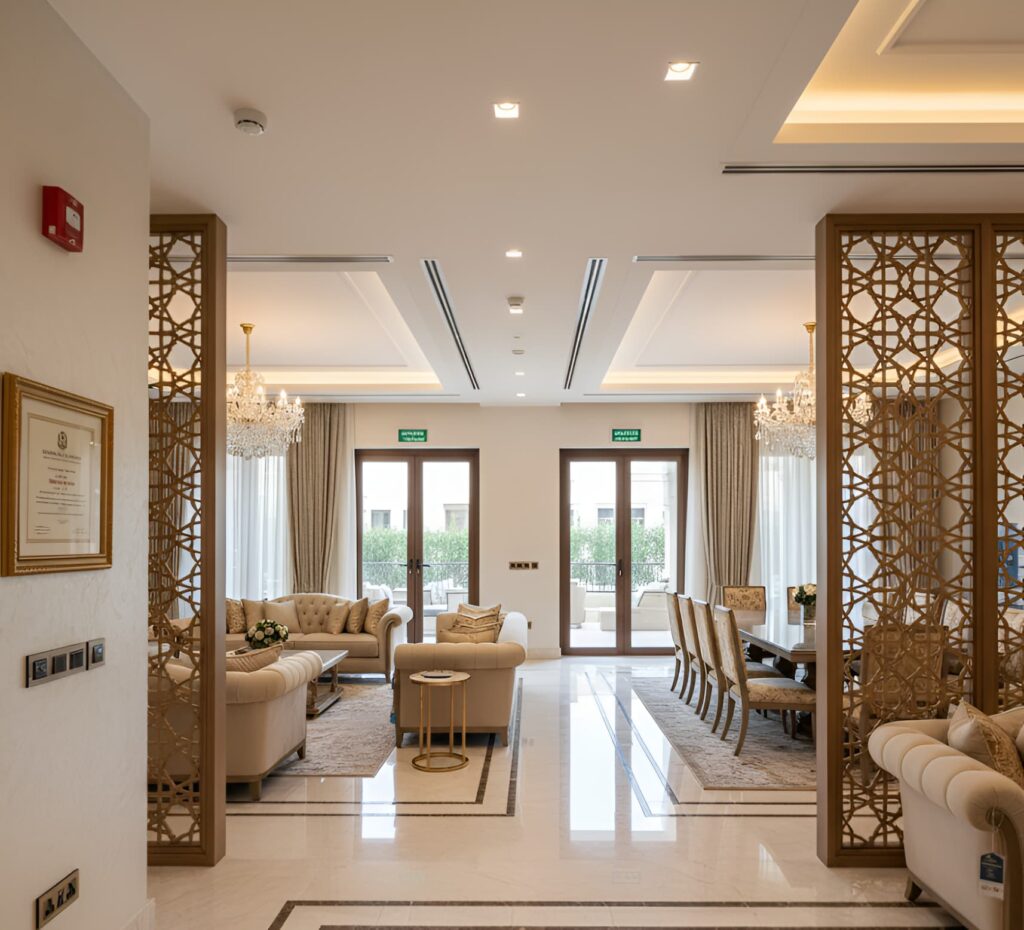Have you ever dreamed of transforming your Dubai apartment or villa into a stunning, personalized space? The excitement of choosing colors, furniture, and layouts is undeniable. But before the first piece of furniture is ordered, there is a crucial first step that every homeowner and tenant must understand: the Dubai Municipality Interior Design Regulations. Navigating these rules is the key to a smooth, legal, and successful renovation.
This guide will walk you through everything you need to know, in simple terms, to ensure your project complies from start to finish.
Understanding the Purpose of These Regulations
You might wonder why such strict rules exist for something happening inside your own property. The answer is safety and harmony. The Interior Design Regulations in Dubai are not meant to make your life difficult. They are designed with very important goals in mind. First and foremost, they ensure the structural safety of the building. Any interior change, especially those involving walls, must not compromise the building’s strength.
Secondly, they guarantee the safety of everyone inside by regulating electrical work, plumbing, and materials used, making sure they are fire-resistant and non-toxic. Finally, these rules help maintain a standard of quality and prevent alterations that could negatively affect your neighbors or the building’s shared infrastructure. Think of them as a protective framework that benefits everyone.
The Crucial First Step: The No Objection Certificate (NOC)
The most important term you will encounter is the No Objection Certificate, or NOC. This is a formal letter of permission. You cannot start any significant interior work without it. There are two main NOCs you will need to secure before applying for a permit from the Dubai Municipality. The first is from your landlord if you are a tenant. You must present your design plans to them for approval.
The second NOC comes from your building’s management or owners’ association. They need to review your plans to ensure they do not disrupt common areas, violate building policies, or affect other residents. Getting these NOCs is your responsibility and is the foundation of your permit application.
Securing Your Dubai Municipality Interior Permit
Once you have the necessary NOCs, the next step is to apply for the official interior design permit from the Dubai Municipality. This process is done through the municipality’s online system. You cannot do this yourself unless you are a licensed interior design consultant or engineer registered with the municipality. This is where hiring a professional becomes essential.
A licensed interior designer or consultant will prepare and submit all the required documents on your behalf. These documents typically include detailed architectural and electrical drawings, a layout of the new space, and specifications for the materials to be used. The municipality reviews these plans to check for compliance with all regulations. Only after they approve can your project physically begin.
Key Areas Regulated by Dubai Municipality
The regulations cover almost every aspect of an interior fit-out. Knowing these key areas will help you plan your project effectively and avoid common mistakes.
Structural Integrity and Wall Modifications
This is a major focus. You are generally prohibited from altering or removing any structural walls, columns, or beams as they are critical to the building’s stability. For non-structural walls, changes are often possible but require approval. The municipality must see engineering drawings that confirm the changes are safe. This is a critical area where professional guidance from the best interior company in Dubai is invaluable, as they understand what is permissible.
Electrical and Plumbing Works
All electrical wiring and plumbing installations must adhere to strict Dubai Municipality standards. This ensures safety from electrical fires and water leaks. Using unlicensed contractors for this work is risky and will lead to permit rejection and potentially dangerous living conditions. Your plans must show the new electrical outlets, lighting circuits, and any changes to plumbing fixtures. All work must be carried out by certified technicians.
Materials and Finishes
The materials you choose for your floors, walls, and ceilings are also regulated, particularly for fire safety. Materials must have the necessary fire resistance ratings. For example, certain types of wooden cladding or flooring may require special treatment. This extends to furniture as well, especially in commercial projects. Using approved materials is non-negotiable for passing the final inspection.
Health and Safety During Construction
The regulations also cover the construction phase. Your contractor must ensure that the worksite is safe, that debris is properly disposed of, and that common areas are protected from damage. Noise and work hours are also often regulated by your building management to minimize disruption to neighbors.
The Final Inspection and Getting Your Completion Certificate
After the construction work is finished, the journey is not quite over. The Dubai Municipality will conduct a final inspection of your property. A municipal inspector will visit the site to verify that the executed work matches the approved plans and complies with all regulations. They will check the quality of workmanship, electrical installations, and material compliance. If everything is in order, they will issue a Completion Certificate. This document is your official proof that the project has been completed legally and to standard. It is crucial for closing the permit file and is often required by landlords.
Why Working with a Professional is Essential

Trying to navigate the permit process alone is complex and likely to result in delays, rejections, or fines. A licensed interior design consultant does more than just create beautiful spaces; they act as your guide through the regulatory maze. They understand the specific requirements, prepare the correct documentation, liaise with the municipality, and ensure that the contractors follow the rules.
For a project as important as your home, especially when looking for the best interior designer for villas, their expertise is an investment that saves you time, money, and stress. They can also offer creative interior design ideas that are both stunning and compliant.
Conclusion
Understanding and adhering to the Dubai Municipality Interior Design Regulations is the fundamental key to a successful and stress-free home transformation. It is a process designed to protect your investment and ensure your safety. While the rules may seem detailed, they are manageable with the right partner by your side.
For a seamless experience from concept to completion, consider partnering with a reputable firm like Rawaa Interiors. Our team of licensed professionals is well-versed in every aspect of the municipality’s requirements and can bring your vision to life while ensuring full compliance. Ready to start your project? Contact Rawaa Interiors today at interiorsbyalrawaa@outlook.com or call +971 50 222 8146 or +971 52 934 3293.
Frequently Asked Questions
Do I need a No Objection Certificate (NOC) before starting interior work?
Yes. Tenants must obtain an NOC from both the landlord and the building management or owners’ association. These approvals confirm that your plans follow building policies and will not disturb structural integrity or common areas.
Who can apply for the Dubai Municipality interior design permit?
Only a licensed interior designer or engineer registered with the municipality can apply. They prepare detailed drawings, material specifications, and electrical plans to ensure your project meets every regulation before construction begins.
Are there restrictions on altering walls or structural elements?
Yes. Removing or changing structural walls, columns, or beams is generally prohibited. Non-structural modifications can be approved only after engineering drawings prove the changes are safe and will not weaken the building’s stability or impact neighboring units.
What safety standards apply to electrical and plumbing work?
All wiring and plumbing must follow strict Dubai Municipality codes. Certified technicians must handle installations to prevent fire hazards, leaks, or permit rejections. Plans must clearly show new outlets, circuits, and plumbing fixture changes for approval.
What happens after construction is completed?
A Dubai Municipality inspector conducts a final site visit to verify that all work matches approved plans and safety standards. If everything complies, you receive a Completion Certificate, the official document proving your project is legally finished.

